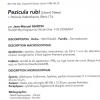
07-03-2012 11:34
 Alessio Pierotti
Alessio Pierotti
Qualcuno può aiutarmi ? Sto cercando il seguente

07-03-2012 12:35
Marja Pennanenbut suppose mali came to me ;)Hi,I found these hai

04-03-2012 17:55
Roland LabbéRe-bonjour ! Voici une autre planche et une photo
Pezicula / biblio
Alessio Pierotti,
07-03-2012 11:34
 Qualcuno può aiutarmi ? Sto cercando il seguente lavoro:
Qualcuno può aiutarmi ? Sto cercando il seguente lavoro:Martin J.M. 1998 Pezicula rubi (Libert) Niessl = Pezicula rhabarbarina (Berk.) Tul. Bull. trim. Féd. mycol. Dauphiné-Savoie 148: 25-26.
Grazie !
Migliozzi Vincenzo,
07-03-2012 12:01
Re : Pezicula / biblio
Ciao Alessio
te lo posso inviare io.
Enzo.
te lo posso inviare io.
Enzo.
Alex Akulov,
07-03-2012 12:04

Re : Pezicula / biblio
Ciao, Alessio
I have not this paper, but you can ask for it at the site:
http://moliere.grenoble.fr/modules/webportal/results.php?op=seealso&idbase=2&fields=Revue&value=Bulletin%20trimestriel%20de%20la%20f%E9d%E9ration%20mycologique%20Dauphin%E9-Savoie
Alex
I have not this paper, but you can ask for it at the site:
http://moliere.grenoble.fr/modules/webportal/results.php?op=seealso&idbase=2&fields=Revue&value=Bulletin%20trimestriel%20de%20la%20f%E9d%E9ration%20mycologique%20Dauphin%E9-Savoie
Alex
Alessio Pierotti,
07-03-2012 20:38

Re : Pezicula / biblio
Enzo, grazie mille: mi faresti una cortesia. Mia moglie mi ha detto che hai telefonato diverse volte: avevo lasciato a lei il mio cellulare (il suo era morto...). Io ero in Sardegna per lavoro: sono rientrato sabato...ci vediamo presto nel Forum.
Alex ! Come stai ?
Alex ! Come stai ?
Migliozzi Vincenzo,
07-03-2012 21:42
Re : Pezicula / biblio
Clicca sul quadratino verde.Ti si allarga l'immagine e tye lo copi...
E' lì da un pò di ore.Ciao.
E' lì da un pò di ore.Ciao.



